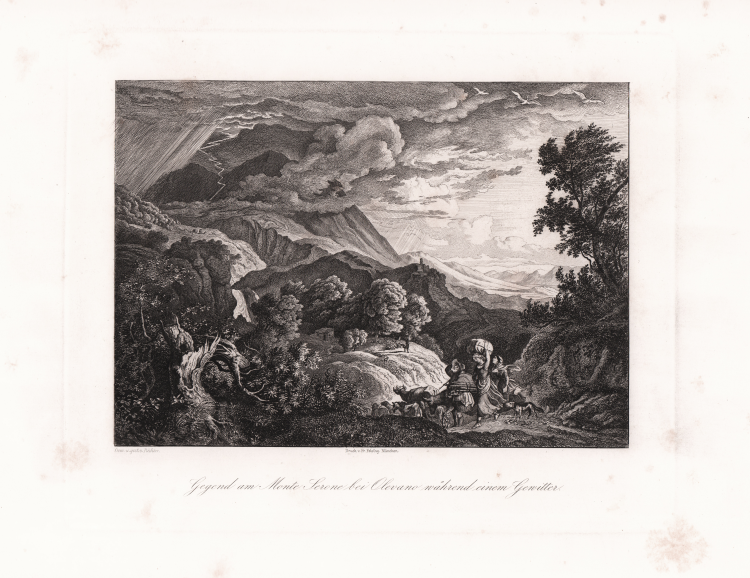



| Reference: | s42065 |
| Author | Adrian Ludwig RICHTER |
| Year: | 1830 ca. |
| Measures: | 290 x 230 mm |


| Reference: | s42065 |
| Author | Adrian Ludwig RICHTER |
| Year: | 1830 ca. |
| Measures: | 290 x 230 mm |
Plate from Die Bilder-Chronik des Sächsischen Kunstvereins Dresden 1828 – 1836. After a painting by Ludwid Richter.
Etching, in very good condition.
At the beginning of the 19th century, a new spirit was stirring in bourgeois society in Germany: Literary circles formed in the cities, supported and attended by reform-minded men and women. This situation prepared the ground for the founding of the first art associations in the German states. During the Dürer celebration in Dresden on April 7, 1828, Carl August Böttiger called for the founding of an art association. Young Saxon artists such as Carl Peschel, Ludwig Richter, Christian Friedrich Gille, Ernst Ferdinand Oehme and many others benefited from this support. But also the representatives of Dresden's early Romanticism such as Caspar David Friedrich, Georg Friedrich Kersting and Louise Seidler were able to sell their paintings through the Kunstverein. The publication of the Bilder-Chronik, in which the purchased works were presented to the members of the Kunstverein as copper engravings, served not only to disseminate contemporary fine art but also to comprehensively promote the art of copper engraving. Basically, the Sächsische Bilder-Chronik from 1828 to 1836 offers the opportunity to gain a comprehensive insight into the development of art in the first half of the 19th century, which led from Classicism to Romanticism and the beginning of Biedermeier Realism.
Adrian Ludwig RICHTER (Dresda 1803 - Loschwitz, Dresda, 1884)
|
Adrian Ludwig Richter, a German painter and etcher, was born at Dresden, the son of the engraver Karl August Richter, from whom he received his training; but he was strongly influenced by Erhard and Chodowiecki.
He was the most popular, and in many ways the most typical German illustrator of the middle of the 19th century. His work is as typically German and homely as are the fairy-tales of Grimm. Richter visited Italy from 1823–1826, and his Thunderstorm in the Sabine Mountains at the Staedel Museum in Frankfurt is one of the rare Italian subjects from his brush. In 1828 he worked as designer for the Meissen factory, and in 1841 he became professor and head of the landscape atelier at the Dresden Academy. The Dresden Gallery owns one of his best and most characteristic paintings: Bridal Procession in a Spring Landscape. An eye disease put a stop to the practice of his art in 1874; he was pensioned in 1877, and died at Loschwitz, near Dresden.
|
Adrian Ludwig RICHTER (Dresda 1803 - Loschwitz, Dresda, 1884)
|
Adrian Ludwig Richter, a German painter and etcher, was born at Dresden, the son of the engraver Karl August Richter, from whom he received his training; but he was strongly influenced by Erhard and Chodowiecki.
He was the most popular, and in many ways the most typical German illustrator of the middle of the 19th century. His work is as typically German and homely as are the fairy-tales of Grimm. Richter visited Italy from 1823–1826, and his Thunderstorm in the Sabine Mountains at the Staedel Museum in Frankfurt is one of the rare Italian subjects from his brush. In 1828 he worked as designer for the Meissen factory, and in 1841 he became professor and head of the landscape atelier at the Dresden Academy. The Dresden Gallery owns one of his best and most characteristic paintings: Bridal Procession in a Spring Landscape. An eye disease put a stop to the practice of his art in 1874; he was pensioned in 1877, and died at Loschwitz, near Dresden.
|